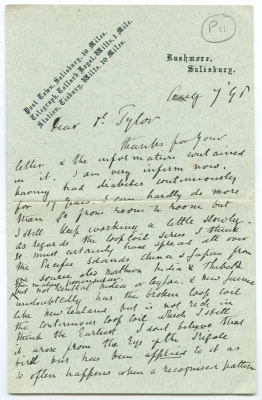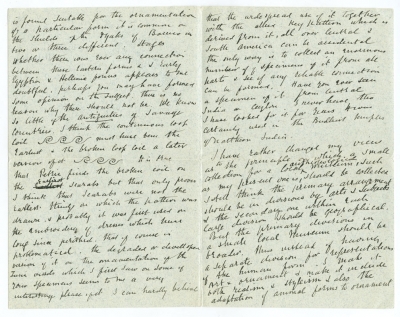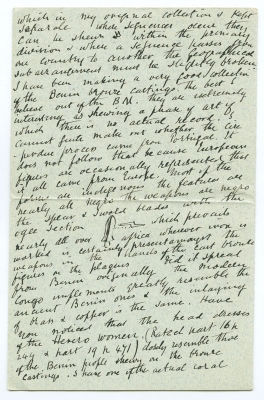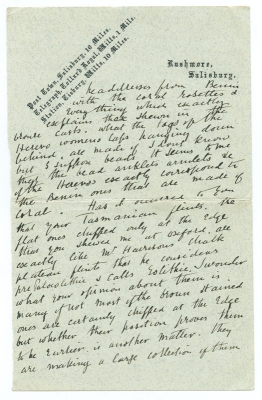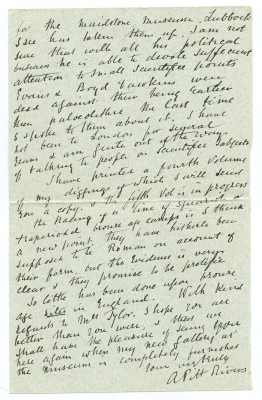Tylor papers Box 13 P11
L1400 [S&SWM PR papers]
Linden | Wellington, Somerset | Sep. 23 1895
Dear General Pitt Rivers
The photograph of the wonderful flint knife & its handle has come on to me here, & some day I hope to be able to examine the original. It seems a most interesting feature that the carvings of animals should not be a hieroglyphic inscription but a procession of animals, no doubt characteristic of the country of the tribe who made the knife. One thinks of the carved horns from the other side of Africa
The prospects of Anthropology at Oxford are just now really cloudy. When the scheme of an examination & degree in Anthropology was thrown out at the last stage by Convocation at the end of the past term, it was said more than once that anthropology ought to be given over to the Faculty of Literae Humanioies to be placed among the extra subjects of the "Greats" examination. Apparently the main motive of the successful opposition to Anthropology having an examination in the Science Faculty where it belongs was that it might be captured thus by the Classical School. You know I think what sort of answer I shall give to such a proposal if it comes to me in a definite form, but in that case I shall communicate with you at once and ask you to intervene.
Yours very truly
Edward B Tylor
------------------
Tylor papers Box 13 P11, Pitt Rivers Museum
[Note that this letter may be an answer to the one shown here, L2170 S&SWM]
Rushmore | Salisbury | Aug 7 '98
Dear Mr Tylor
thanks for your letter & the information contained in it. I am very infirm now, having had diabetes continuously for 17 years. I can hardly do more than go from room to room but I still keep working a little slowly. As regards the loop coil series I think it must certainly have spread all over the Pacific Islands China & Japan from the source also Northern India & Thibet & [insert] the Malay peninsula [end insert] but not central India or Ceylon. New Guinea undoubtedly has the broken loop coil like New Zealand but is not rich in the continuous loop coil which I still think the Earliest I dont believe that it arose from the Eye of the Frigate bird but has been applied to it as so often happens when a recognised pattern is found suitable for the ornamentation of a particular form it is common on the shields of the Dyaks of Borneo in two or three different stages Whether there was ever any connection between these eastern forms & Early Egyptian and Hellenic forms appears to me doubtful. Perhaps you may have formed some opinion on the subject. there is no reason why there should not be. We know so little of the antiquities of Savage Countries. I think the continuous loop coil [drawing] must have been the earliest & the broken loop coil a later version of it [drawing] It is true that Petrie finds the broken coil on the earliest scarabs but that only proves I think that scarabs were not the earliest things on which the pattern was drawn & probably it was first used on the embroidery of dresses which have long since perished that of course is problematical the degraded or [word illegible] version of it on the ornamentation of the Zuni vessels which I first saw on some of your specimens seems to me a very interesting please [sic illegible word] I can hardly believe that the widespread use of it together with the allied key pattern which is derived from it, all over Central & South America can be accidental the only way is to collect an enormous number of specimens of it from all parts and see if any reliable connection can be formed. Have you ever seen a specimen of it from Central India or Ceylon I never have tho I have looked for it for years It was certainly used in the Buddhist temples of northern India.
I have rather changed my views as [insert] to [end insert] the principle on which a small collection for a local [insert] anthropological [end insert] museum, such as my present one is, should be collected I still think the primary arrangement should be in divisions by arts & subjects & the secondary one within each large division should be geographical. But the primary divisions in a small local Museum should be broader, thus instead of having a separate division for representations of the human form I make it Art and Ornament and make it include both realism and styleism and also the adaption of animal forms to ornament which in my original collection I kept separate. Where sequences occur they can be shewn within the primary division and where a reference passes from one country to another the geographical sub-arrangement must be slightly broken I have been making a very good collection of the Benin bronze castings. The best I believe out of the BM. They are extremely interesting as shewing a phase of art of which there is no actual record. I cannot quite make out whether the cire-perdue process came from Portugal. It does not follow that because European figures are occasionally represented that it all came from Europe. Most of the forms are indigenous the features are nearly all Negro the weapons are negro the spear & sword blades with the ogee section [drawing] which prevails nearly all over Africa wherever iron is worked is certainly present amongst the weapons in the hands of the cast bronze figures on the plaques. Did it spread from Benin originally the modern Congo implements greatly resemble the ancient Benin ones & the inlaying of brass & copper is the same. Have you noticed that the head dresses of the Herero women (Ratzel part 16 p 244 and part 19 p 471) closely resemble those of the Benin people shewing on the bronze castings. I have one of the actual coral headdresses from Benin with the coral rosettes & every thing which exactly explains those shewn in the bronze casts. What the tags on the Herero womens caps hanging down behind, are made of I dont know but I suppose beads It seems to me that the bead anklets armlets &c of the Herero exactly correspond to the Benin ones that are made of coral. Has it occurred to you that your Tasmanian flints the flat ones chipped only at the edge that you shewed me at Oxford, are exactly like Mr Harrisons chalk plateau flints that he considers pre Palaeolithic & calls Eolithic. I wonder what your opinion about them is many if not most of the brown stained ones are certainly chipped at the edge but whether their position provies them to be earlier is anothe rmatter. they are making a large collection of them for the Maidstone Museum. Lubbock I see has taken them up. I am not sure that with all his political business he is able to devote sufficient attention to small scientific points Evans & Boyd Dawkins were dead against their being earlier than palaeolithic the last time I spoke to them about it. I have not been to London for several years & am quite out of the way of talking to people on scientific subjects.
I have printed a fourth volume of my diggings of which I will send you a copy & the fifth vol is in progress the tracing of a line of [illegible word] or trapezoidal bronze age carvings is I think a new point. they have hitherto been supposed to be Roman on account of their form but the evidence is very clear & they promise to be prolific.
So little has been done upon bronze age sites in England. With kind regards to Mrs Tylor. I hope you are better than you were, I think we shall have the pleasure of seeing you here again when my new gallery at the Museum is completely furnished
Yours very truly
A Pitt Rivers
Transcribed by AP March/ June 2011, for the Rethinking Pitt-Rivers project
